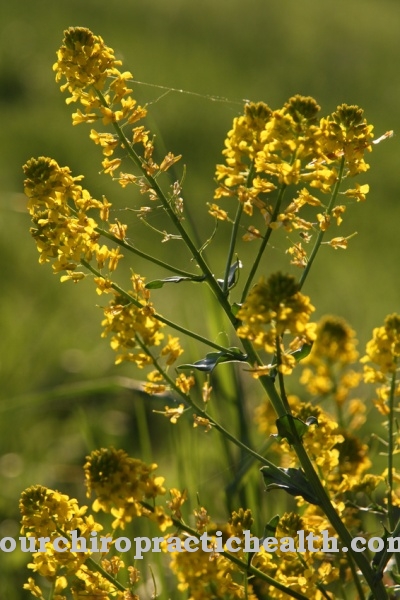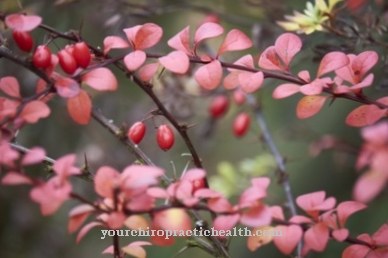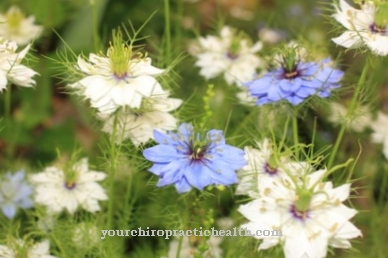The Real cowslip is popularly also called Sky key or Medicinal primrose known. The primrose plant with the delicate yellow flowers grows as a herald of spring in large parts of Europe and thrives as a pretty ornamental plant in many gardens. The cowslip has also been used as a medicinal plant in natural medicine for centuries.
Occurrence & cultivation of the cowslip

In most Central European countries, wild cowslips may only be collected with a special permit, since the rhizome in particular, but also the parts of the plant located on the surface, are protected. The flat-growing rhizome is firmly anchored in the earth with many small fiber roots. The oblong, egg-shaped leaves are wrinkled and have a short stalk: they sit close to the ground.
From March to April sweet-smelling golden yellow flowers appear on long, delicately hairy stems. The whole perennial becomes 15 to 30 cm high. The low leaf rosette stays green over winter. Some people have an allergic reaction to touching fresh plants. There is also the risk of an allergic reaction when consuming keyflower tea, for example in the form of irritation of the mucous membrane.
Application & effect
Like many spring flowers, the cowslip is seen as a protective and fertility agent. Cowslips consecrated on Palm Sunday, usually in the number three, are said to help against fever, sore throat and toothache. In addition, they used to have powers of defense against demons.
The most important active ingredients are saponins (primulic acid): these are particularly abundant in the roots, and more sparingly in the sepals. In the yellow flowers, however, the active ingredients are not found at all. There are also essential oils, tannins, flavones, silica and primulaverine. The cowslips dissolve coughs and mucus, they also have a diuretic effect, strengthen the heart and help with insomnia and migraines.
The plant is still used today in naturopathy and homeopathy, mostly in the form of an infusion / tea. Key flower tea made from dried roots, flowers and leaves is mixed with cold water and then heated to a boil. Cowslips can also be mixed with other cough herbs, such as coltsfoot, mallow, and violet.
The famous Swiss herbal priest Künzle recommended a tea made from freshly picked cowslips as a tasty remedy for headaches and stressed nerves. Collectors should leave wild plant stocks untouched and instead fall back on tested pharmacy goods. Of course, the medicinal plant can also be cultivated in the home garden. It loves dry, chalky soil and a sunny location. The plants are well suited for a ground-covering carpet planting, for example in front of shrubs. Before planting, the soil should be well fertilized with ripe compost and a little algae lime.
The harvest time for the flowers is from April to May. For teas, the flowers with a calyx but without a stem are mainly used. The roots are dug up before flowering in March and the earth washed off. Then the flowers should be carefully dried in an airy and shady location. The roots, on the other hand, can be split lengthways and stored in a warm and shady place.
The flowers can remain whole for the individual tea preparation, the small cut is recommended for the tea mixtures. The main and secondary roots are to be cut uniformly small. After drying, the flowers can be stored in opaque glasses or porcelain vessels, the roots in wooden or aluminum boxes.
Importance for health, treatment & prevention
By researching the ingredients, the effects on respiratory diseases could be demonstrated. The cowslip is indicated for the treatment of stubborn cough, which makes it difficult to cough up the thick mucus. It is particularly suitable for chronic bronchitis, which is associated with ailments of the heart, especially for elderly people (old age heart), as the slightly diuretic effect also relieves the circulation.
For centuries the cowslip had an important role in folk medicine. Pastor Sebastian Kneipp also recommended the use of the spring flower for healing purposes: “Anyone who has a tendency to addiction to limbs, drink a cup of keyflower tea for a long time. The severe pain will ease and eventually go away completely. "
Today it is only used in alternative naturopathy or in homeopathy. Keyflower tea, for example, is a tried and tested remedy for the medicine cabinet, but it cannot replace a doctor if you have a persistent cough. For a keyflower tea, one or two heaped teaspoons of dried flowers with goblets can be scalded with a quarter liter of boiling water. The brew takes about ten minutes and is then strained. The tea should be drunk warm. If necessary, it can also be sweetened with a little honey or rock candy.
In addition to teas, primrose extracts are also available in the pharmacy. As with any other medical treatment, side effects cannot be ruled out. When using cowslips, allergic reactions, stomach pain and nausea can occur. In particular, allergic reactions of the skin are quite common, as the ingredients of the plant not only irritate the bronchi as desired, but also sensitive skin. If (itchy) rashes suddenly occur in connection with the consumption of key flower tea, the brew should no longer be drunk.


.jpg)

























